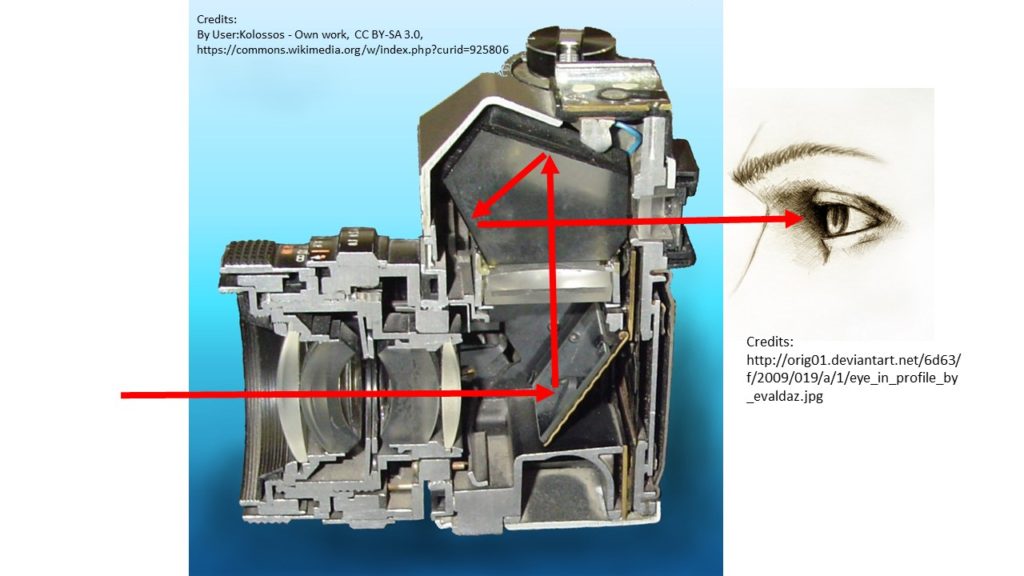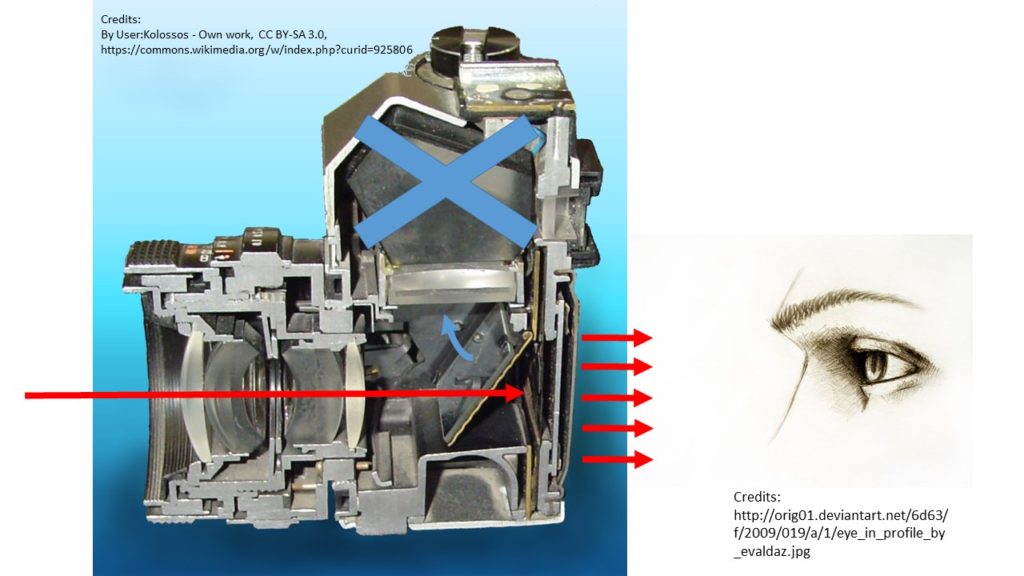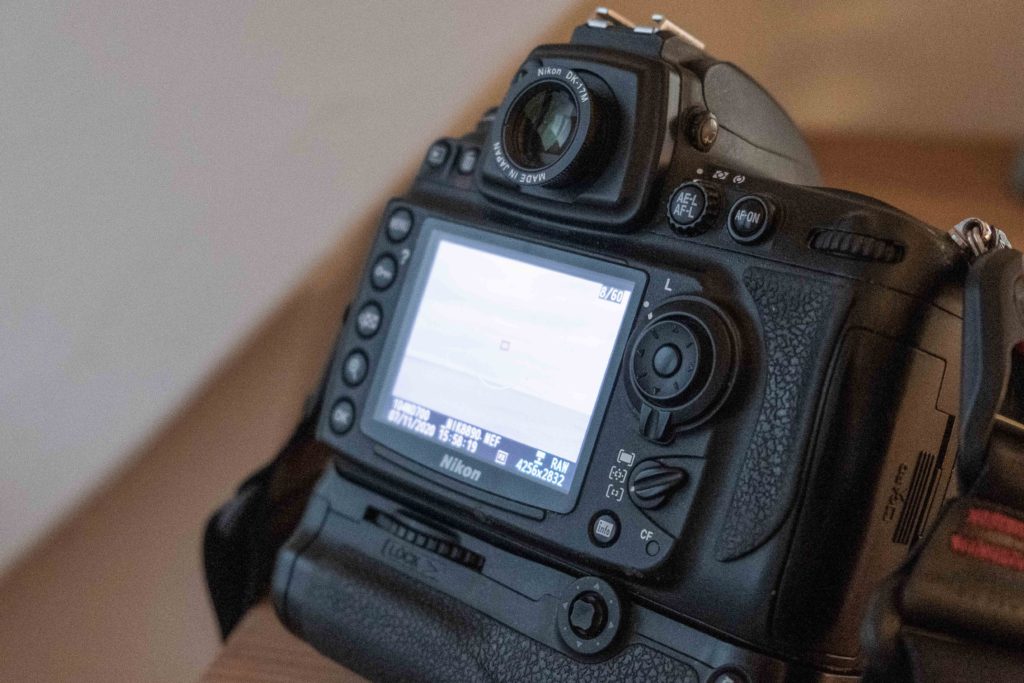The evolution of cameras
Ever since the film days, SLR (Single lens reflect) cameras were built with a mirror behind the lens, that sends the light from the lens up into a pentaprism, that passes the light on to the viewfinder for the photographer to see. When the shutter is pressed, the mirror flicks up, exposing the film or the sensor behind it and the content captured will be the same as what the photographer could see in the viewfinder. During this process, the viewfinder turns black as the mirror blocks the light.

With the introduction of Digital SLRs, the film was replaced by a sensor that not only can read the light in a fraction of a second, but actually can do so constantly, which opens up for shooting movies. Further, many DSLRs today are equipped with a large screen on the back to present menus and options for configuring the camera, plus previewing the pictures.
Live view combines the sensor and the LCD on the back of the camera, so that the camera continuously shows on the screen what the sensor receives. As the mirror, when it is down, blocks the light from the sensor, the DSLR will – when it is put in live view mode – flick the mirror away to allow the light continuously to flow to the sensor:

The camera will – subject to the processing capacity – try to make what is viewed on the screen as close to real time view as possible, but for older cameras you will notice a lag or a bit of delay in what is shown in the rear screen.

Some cameras allow you to flip the screen upwards or downwards, and some are even fully articulating, allowing you to swing the screen 180 degrees around to be viewed from the front of the camera. Many vloggers use this feature to view themselves when recording video. The rear screen on the older Nikon D700 depicted above is fixed and cannot be moved at all.
So what is the point?
So other than this now being technically possible, what is the point with Live View, if any? I think there are several:
First of all, sometimes the optical viewfinder is hard to use, for example when you try to shoot in a very low or a very high angle. You may want to shoot over a crowd at a concert, or shoot very low to get a certain angle of view. In those cases it can be difficult to put your eye to the viewfinder, unless you either have brought along a ladder an/or want to crawl on the ground. Especially if your camera has a tilt screen, then you will love this feature, but even with a fixed screen the Live View is a big help.
Second, the fact that the rear screen is a processed version of what hits the sensor, it is possible to combine what the sensor sees with various electronic overlays like a large virtual horizon indicator. I use that a lot to secure that my landscape pictures are level. Another example is focus peak indicators, where the screen shows which parts of the picture is in focus – it can be in the shape of say red colored dots. This is a great aid in obtaining focus when shooting with a lens without autofocus. A third example is to show picture in picture, i.e. the normal picture and then a smaller frame inside the picture where a zoomed in version of the picture is shown, again to aid focus.
Third, maybe a variation of the second, is that you can zoom in on the picture in the rear screen. Again this feature is super useful if you shoot with a manual focus lens and want to zoom in to make sure you have nailed focus.
A fourth benefit of Live View is that the camera typically does not use the dedicated focus system, but instead used the sensor and a bit of processing power to obtain focus. As many elder cameras have the focus points only in the center of the frame, you cannot obtain focus say in the corners. With Live View this limitation is gone and for single point focus you can use all of the frame to select your focus point. Especially macro photography shooters with elder cameras use this feature a lot.
Finally, when shooting into the sun, the light that you see on the rear screen is a processed version of reality and I doubt that the LCD screen is so powerful that it can blindfold you. When shooting into the sun using the optical viewfinder, I often find that I am blindfolded temporarily when staring straight into the sun. So I often turn to Live View in those cases. Notice that many camera manufacturers warn against shooting into the sun, both in Live View and using the optical viewfinder, so please consult the manual for your camera beforehand.
Any downsides?
The rear screen requires power to operate, and a lot more than the optical viewfinder where that part of the process is purely mechanical. So you will find that your batteries will be eaten faster than when shooting using the optical viewfinder.
For elder cameras, you may find that live view is sloooow. Very slow. It takes ages from you hit the shutter to the picture is done. On my Nikon D700 for example, the focus part alone takes several seconds (when in Tripod mode), where it for later models (the D750 for example) is much better.
And finally sunshine is not your friend if you shoot outside on a sunny day. It is like watching TV outside. It can be difficult to see the screen.
Thank you
Thank you for reading this far. Comments, questions and suggestions are more than welcome!
Credits
Illustrations used:
User: Kolossos – Own work, CC BY-SA 3.0, https://commons.wikimedia.org/w/index.php?curid=925806
http://orig01.deviantart.net/6d63/f/2009/019/a/1/eye_in_profile_by_evaldaz.jpg
